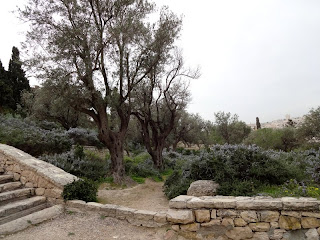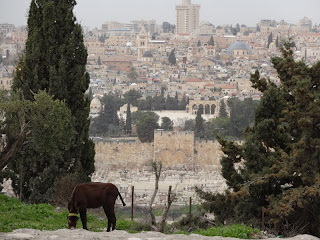I have often wondered how the prophecies were fulfilled that Christ would lay for three days and three nights in the tomb before his Resurrection, when He was crucified on a Friday and rose again early on a Sunday morning? The time requirement was too short! Thirty-six hours does not equal three days.
But if Jesus held his own Passover meal on Wednesday night, and was taken to the cross on
Thursday, the timing is right. And it seems that is what happened.
So instead of Good Friday, we should have Good Thursday.

Although there is a church and a garden "Gethsemane" with 2-thousand-year-old olive trees in it down at the base of the Mount of Olives, our guide took us higher up the hillside, citing a portion of the Law that said the annual atoning sacrifice of the red heifer had to take place opposite the Temple and in line with the Gate Beautiful. And Jesus came to fulfill the Law.
We sat on the hillside, looking across at the Gate Beautiful, the gate only used for priests to enter into the Temple. (The Moslems don't want the Christians to be thinking it is a gate that's accessible so they bricked-in the entrances. They also purposely put a cemetery there so that Christ, as a priest, couldn't walk through without being defiled, when He comes again. It's their way of saying those prophecies are worthless.) By the way, the Dome of the Rock seems to be a bit to the south of the location of the ancient Temple. Theoretically, a temple could be there without the Dome having to be moved.
Such a peaceful, pastoral location, away from the crowds!
Not much has changed.
And here we talked about wine presses and olive presses.
The Garden is the place of the olive press, but Christ said he had trodden the wine press alone,
as the Atonement was begun, where he sweat great drops of blood.
As it turns out, it could have been both presses.
With an olive press, a large stone is rotated to crush the olives. The first oil that is released is reddish (extra-virgin olive oil) and was used for anointings and the candelabra in the temple. Under more pressure--the pit is crushed and more oil comes--that used for food and light for homes. More pressure, and then comes the oil used for medicines and industry. The mash that was left was dried and burnt for fuel.
Grapes are first trodden by foot, to avoid crushing the seeds which are bitter, then the seeds are taken to the olive press, where, under great pressure, grape-seed oil is obtained, along with a very bitter liquid that is used to make vinegar; "the bitter cup..."
Gethsemane: where both processes meet to produce the most intense and bitter experience.
The entrance to the lower "Garden of Gethsemane".
Who knows where exactly on this hillside the Savior knelt and experienced the worst pain any mortal or God could experience as he began the process of making payment for the sins of all mankind, and where his disciples grew sleepy and could not keep watch?
I cannot even begin to fathom His experience. I'm just so grateful it occurred and He was willing.





I've been thinking about the Good Thursday idea. It does make a lot of sense for Christ to have been crucified on a Thursday, instead of a Friday. However, why then was the burial so rushed? From Mark, it seems that they rushed because the Sabbath was coming up, and they couldn't be in the tomb. If Christ was crucified on a Thursday, then there wouldn't be any reason to rush, as they still had a full day before the Sabbath. Just wondering how it all fits. But John does say that the priests wanted to hurry the trial so that they could prepare for the passover. So, I don't know how it all fits.
ReplyDelete